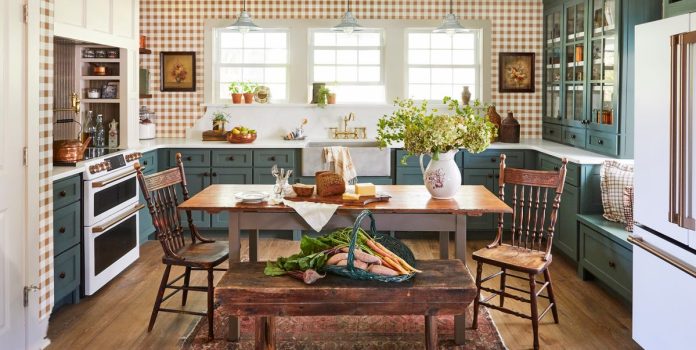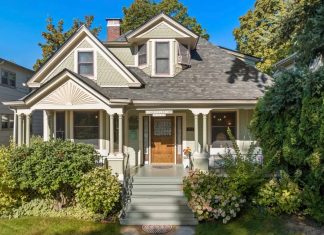Get out your copper cookware and dust off those Longaberger baskets, the ’80s country kitchen is having a revival. Whether you lived through the decade first-hand or revisited it watching The Golden Girls, or more recently, The Goldbergs, the familiar kitchen stylings of those honey-hued cupboards that framed family life are tapping into the cozy nostalgia we need right now.
“There are these little nods to that era of the past that provide really warm, comforting elements,” says Minneapolis interior designer Deidre Webster, founder of Studio Day Design. “Those interiors were a little more personal and layered, and maybe it’s because we didn’t have social media. It wasn’t this constant push of doing what everyone else is doing.”
Psychologist Arlene Kagle, quoted in a 1988 New York Times article about the rise of country decor, put it this way: “Country decorating makes us feel right and righteous and deeply at home.” The founding editor of Country Living, JoAnn Barwick, also spoke to the trend in that same story: “There are no rules. It is a very forgiving style.”
Indeed, what comes around goes around. The familiar hallmarks of the 1980s country kitchen continue to populate Pinterest boards and are being re-welcomed back into homes today. Here are 6 design trends of 1980s country-style kitchens that are worthy of a comeback. (But maybe we can all agree, this time around, let’s skip the dusty fake trailing ivy and dropped ceiling light box. Like wall-to-wall carpeted kitchens, some things are best left in the past.)
Muted Colors
The decade that made mauve and pastels popular doesn’t easily translate—nor should it, arguably—into today’s country kitchens. For painting walls and cabinets, designer Christina Salway says she’s drawn to more muted colors—ochre, clay pink, or dusty sage. “I kind of joke about it, but you want all the colors to have a little bit of mud in them. I am really careful to stay away from true pastels, so it doesn’t feel like an Easter basket.”
RELATED: 50+ Pretty Kitchen Paint Color Ideas for Your Next Room Makeover
Mixed Patterns
Similarly, pattern play in the ’80s kitchen varied—whether used as wallpaper, as chair or banquette cushions, sink skirts, or window valances—from garden trellises climbing the walls and Laura Ashley florals to Ralph Lauren’s preppy plaids. Christina says the trick for mixing patterns is to manage the scale and proportions. “The more patterns, the better, but I don’t want it to feel like bedlam,” she says. “There’s a need for the patterns to communicate with each other, not compete. So, you might have a large and small print or a stripe and a wider stripe; it’s about how you balance those things.”
While wallpaper was relatively common in an ’80s country kitchen, another way to reinterpret that vibe is to render patterns in tile backsplashes or flooring. Deidre says she often moves highly patterned wallpapers to the dining room or other adjacent spaces. “The floor or any soft upholstery in the kitchen could also be that interpretation of a wallpaper moment,” she says.
RELATED: 30 Beautiful Ways to Decorate Your Kitchen With Wallpaper
Terracotta Surfaces
Open just about any home décor book from the 1980s and you’ll likely see terracotta tiles lining the kitchen floors and covering countertops. Today, the natural material is once again warming the heart of the home. Companies are bringing back the material with a fresh interpretation of yesterday’s ubiquitous large-format squares. DeVol’s line of handmade terracotta tiles, for example, comes in smooth and rustic finishes and varying shapes and sizes—square, hex, rectangle, and medallions—all of which add a sense of age and a perfectly imperfect weathered patina.
Warm Wood Tones
Wood countertops and freestanding butcher blocks are other ways to bring back warmth and nostalgia. For a farmhouse in Stillwater, Minnesota, Deidre added oak countertops that look as if they had always been there, paired with the homeowner’s existing kitchen cabinets, repainted in a saturated, moody blue, and floral linen café curtains and matching skirted sink. “We didn’t fully retrofit the kitchen, but we wanted it to have more texture and to feel more personal,” she says.
Collectible Displays
Julia Child may have installed her iconic kitchen pegboard in 1961, but the functional wall idea surged in the late ’70s and ’80s. The clever way to display a cookware collection, from copper to cast-iron, never fell out of fashion. Likewise, woven baskets hanging from ceiling beams and spongeware lining open cupboards personalize utilitarian spaces.
Maybe the brass baker’s rack is gone, but displaying collections still conveys a homey kitchen. “I love to accessorize by bringing in baskets—it’s such a great opportunity to add texture without color and pattern, but you’re adding so much dimension,” Christina says. “There are so many fun iterations, hanging them on walls or piling them up helter-skelter on top of an armoire.”
RELATED: 10 Old-School Finds That Add Instant Farmhouse Charm to a Kitchen
Unfitted Layouts
Rarely was there an episode of The Golden Girls when the Miami roommates weren’t chatting it up with cheesecake around the kitchen table. Those timeless Chippendale-style cane chairs they sat in around a cozy eat-in breakfast table are just as right for today’s kitchen, which Christina says is thankfully taking it down a notch from “the mega kitchen.”
Once again, the unfitted kitchen is back, complete with freestanding furniture like butcher blocks that sit beside a range, dining tables replacing massive islands, and stand-alone storage pieces in lieu of another row of built-ins.
“There’s an opportunity to pull back a little, manage things a little less. Like, who wants a massive kitchen island that you can pull a car into?” says Christina. “I feel like the McMansion is going to be the vinyl siding of our generation.”
Kelly Ryan Kegans is a Minneapolis-based writer, editor, and photo stylist with more than 25 years of experience producing home design content for brands including Country Living, Better Homes & Gardens, and HGTV Magazine. Her own home is populated with more books than shelves, a few too many scrubbed pine tables, and moody photos of gray day landscapes, which are her happy place.














